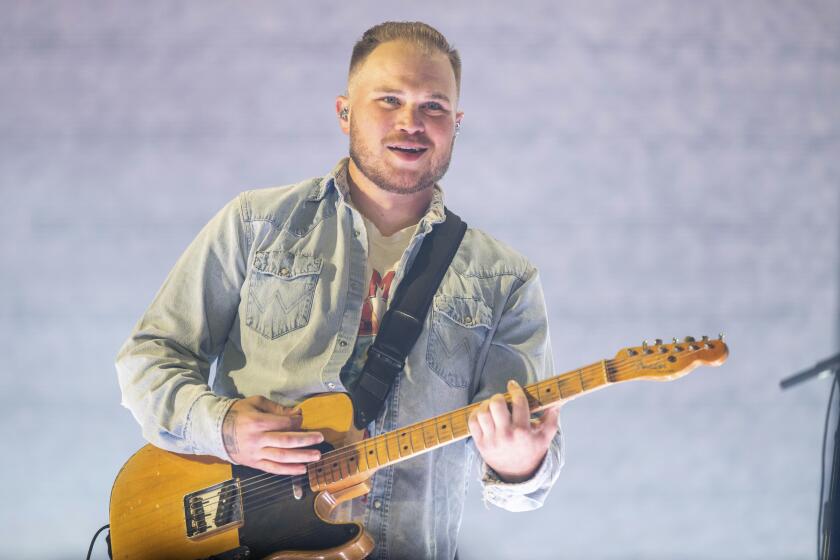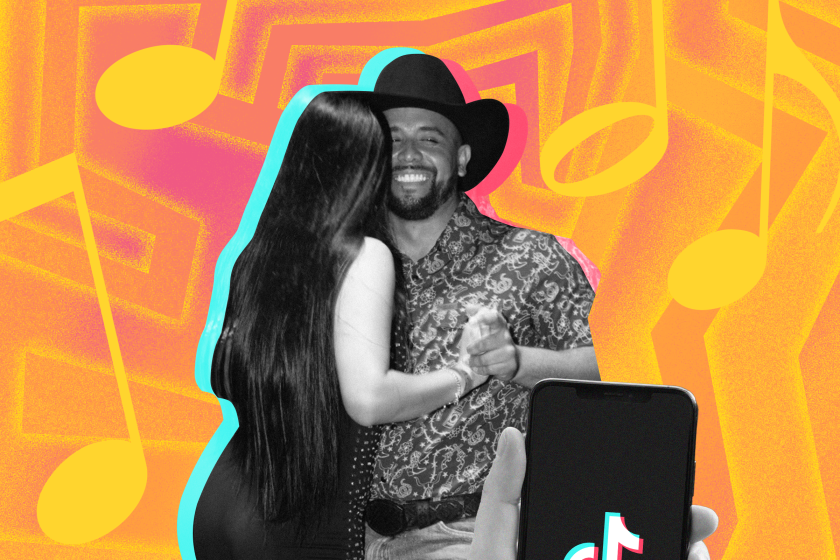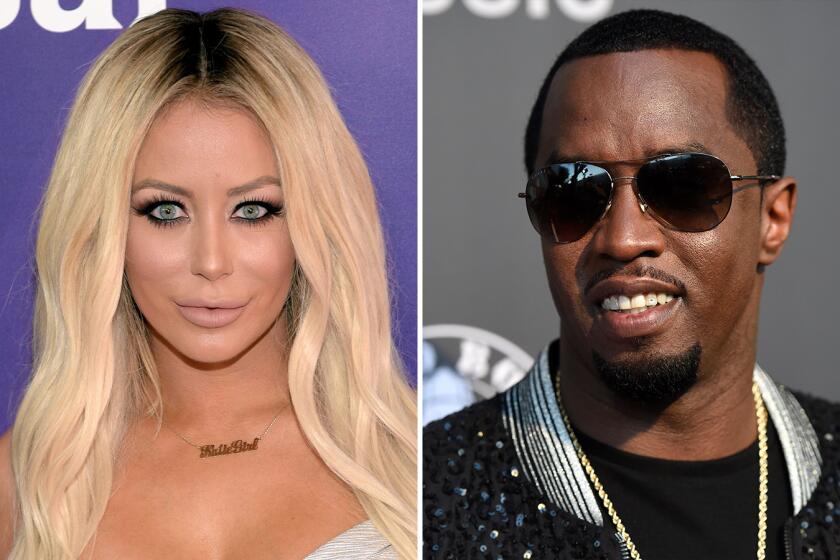COMMON ON LOOKING ‘LIVE’
Common doesn’t fit the hip-hop stereotype. He raps about peace, his jeans fit smartly and he’s the author of three books for young children. “People have the impression that hip-hop is one way, but it’s very broad. There are so many voices,” the Grammy Award winner says. Born Lonnie Rashid Lynn 34 years ago, his first crossover mainstream album was “Like Water for Chocolate” in 2000, and his best-selling--so far--has been 2005’s “Be.” From the song of the same name:
I want to be as free as the spirits of those who left
I’m talking Malcom, Coltrane, my man Yusef
Through death through conception
New breath and resurrection
For moms, new steps in her direction . . .
Waiting for the Lord to rise
I look into my daughter’s eyes
And realize that I’ma learn through her
The Messiah, might even return through her
If I’ma do it, I gotta change the world through her
*
On Jan. 26, Common will make his film acting debut in “Smokin’ Aces,” with Ben Affleck and Alicia Keys; right now he’s wrapping Ridley Scott’s “American Gangster” with Denzel Washington and Russell Crowe. His hat line, Soji, just launched, and his new CD, “Finding Forever,” is due in June. Beyond all that, he runs the nonprofit Common Ground Foundation, which, its website explains, aims to “benefit the spiritual and social development of youth by addressing societal concerns fundamental to the well-being of the hip-hop generation.” But he did find some time to talk to us about style--his.
*
You have a reputation as a dapper fellow. Where does that come from?
Growing up in Chicago in the ‘80s, I was around cats who was into fashion. They were regular dudes who were cool dudes in the neighborhood, dudes who weren’t scared to mix it up, have some high-end piece on with gym shoes. They would be up on Giorgio Armani or Gucci. Gucci belts was “live” in Chicago. The ones with the big G’s. But when I got into hip-hop I was wearing Adidas sweat suits.
You don’t wear so many sweat suits now.
I have definitely evolved. As you get older you get exposed to new things, you start seeing new things. You become more self-confident. But even back then I never wanted to be wearing the same thing that another cat had on. I would go seek out places where a lot of people didn’t go shopping.
Which stores?
I would go pick out stuff from Marshall Field’s or Carson Pirie Scott and even Saks Fifth Avenue--or even one of those boutique stores. You know Girbaud? Marithe Francois Girbaud. I’m from Chicago, but I’m up on France.
Tell me about what you’re wearing right now.
The hoodie is by G-Star. The James Baldwin T-shirt, I bought it on the streets of New York. Baldwin is a Harlem Renaissance poet. I love his writing, and his writing has influenced me. I really like having some substance and culture if I can with whatever I’m doing. And I like the way it fits. It’s not too big. It goes well with the shape of my body.
What do you look for when you’re shopping for clothes?
For me, it’s the fit. If it fits good it helps you feel right.
Have you ever made a fashion faux pas?
Definitely. The first time I ever got to the American Music Awards [in 2003 as a presenter of the new music award] I wore this hat that just threw my whole outfit off. It was wack; it was just weak. It was all these different types of colors, a knit hat, and I actually got put in one of those “fashion don’ts” in a magazine. I was laughing.
In “Smokin’ Aces,” you play Sir Ivy, a well-dressed killer. Did you pick his clothes?
The director [Joe Carnahan] showed the costume designer a picture of Dwyane Wade, a basketball player for the Miami Heat. We chose that look. I think it fit Sir Ivy perfect. He’s a slick, pimpish kind of guy.
The movie is rather violent. Would you let your 9-year-old daughter see it?
No. It’s rated R. Maybe she will eventually see it, but now she’s too young. I really love the film, but I don’t think it’s a children’s story.
You’re multi-tasking these days, but people still think of you as a hip-hop artist.
I don’t think I ever define myself as one thing. There are so many aspects to me as a person. I’m a writer, I love basketball, I love to read good books, I love traveling. I feel like there are a lot of titles that I fit under. I don’t say I’m just a hip-hop guy, but that is part of my culture. But one thing I never want to do is be boxed in.
When did you get into hip-hop?
It was around 1983. I was in grade school. I was listening to Run-DMC and LL Cool J, and Afrika and Bambaataa and this group called UTFO. I just identified with it.
Why?
It was such a good expression for the youthful black culture. I was like, “Dang, that’s us.” For the black and Latino, it was a positive expression, a whole new expression for us. It encouraged me to express myself and gave me the platform to do that.
What about now? What does hip-hop mean to you today?
It’s constantly rebirthing. It’s very diverse. That’s why you have people from the West Coast expressing themselves different from people from the South; you got people from the Midwest saying who they are; you’ve got white rappers, Latino rappers, black rappers, you got Asian rappers. You can go to Japan and see that they dress the way we dress. You can go to parts of Africa and you can see the influence of hip-hop. Which is really giving the cycle back, because it all comes from the African rhythms. It was built on being able to be free.
When did you get into hip-hop?
It was around 1983. I was in grade school. I was listening to Run-DMC and LL Cool J, and Afrika and Bambaataa and this group called UTFO. I just identified with it.
Why?
It was such a good expression for the youthful black culture. I was like, “Dang, that’s us.” For the black and Latino, it was a positive expression, a whole new expression for us. It encouraged me to express myself and gave me the platform to do that.
What about now? What does hip-hop mean to you today?
It’s constantly rebirthing. It’s very diverse. That’s why you have people from the West Coast expressing themselves different from people from the South; you got people from the Midwest saying who they are; you’ve got white rappers, Latino rappers, black rappers, you got Asian rappers. You can go to Japan and see that they dress the way we dress. You can go to parts of Africa and you can see the influence of hip-hop. Which is really giving the cycle back, because it all comes from the African rhythms. It was built on being able to be free.
More to Read
The biggest entertainment stories
Get our big stories about Hollywood, film, television, music, arts, culture and more right in your inbox as soon as they publish.
You may occasionally receive promotional content from the Los Angeles Times.









